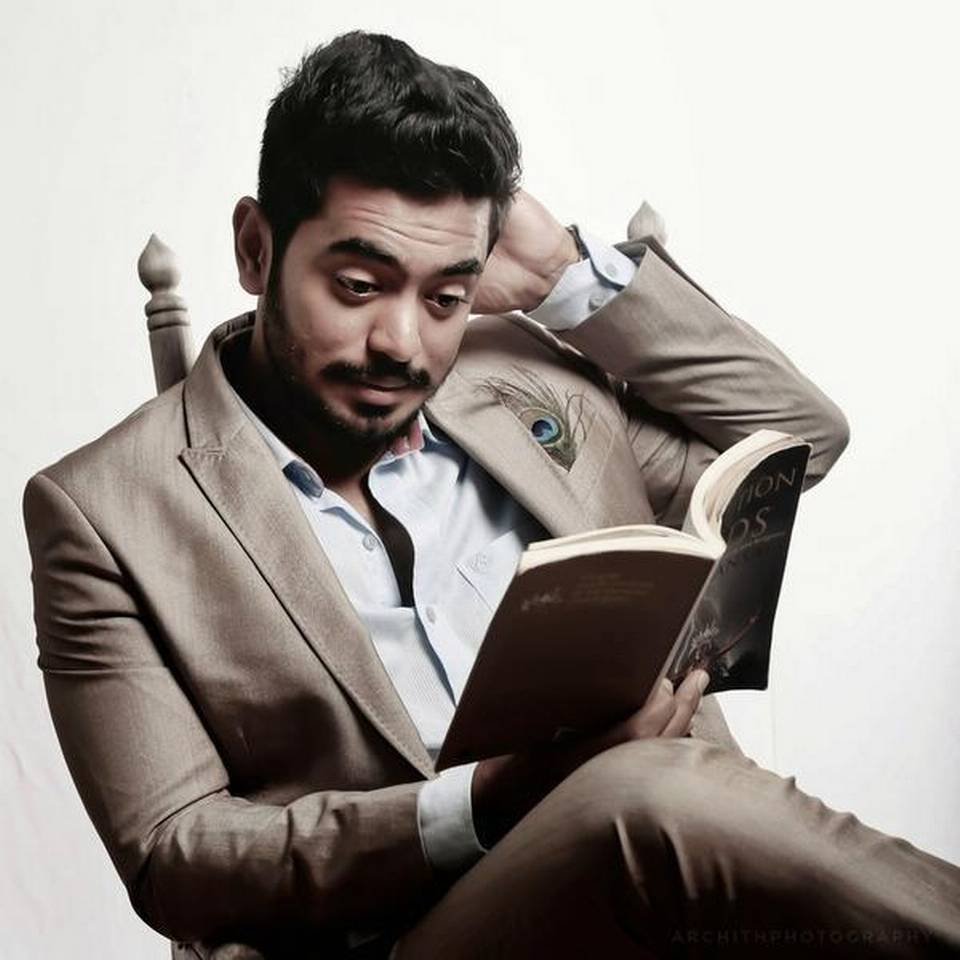Monthly Archives: November 2018
Only a fraction of worthy modern Tamil books have been translated, says N Kalyan Raman
An interview with the acclaimed translator of Tamil literature into English.
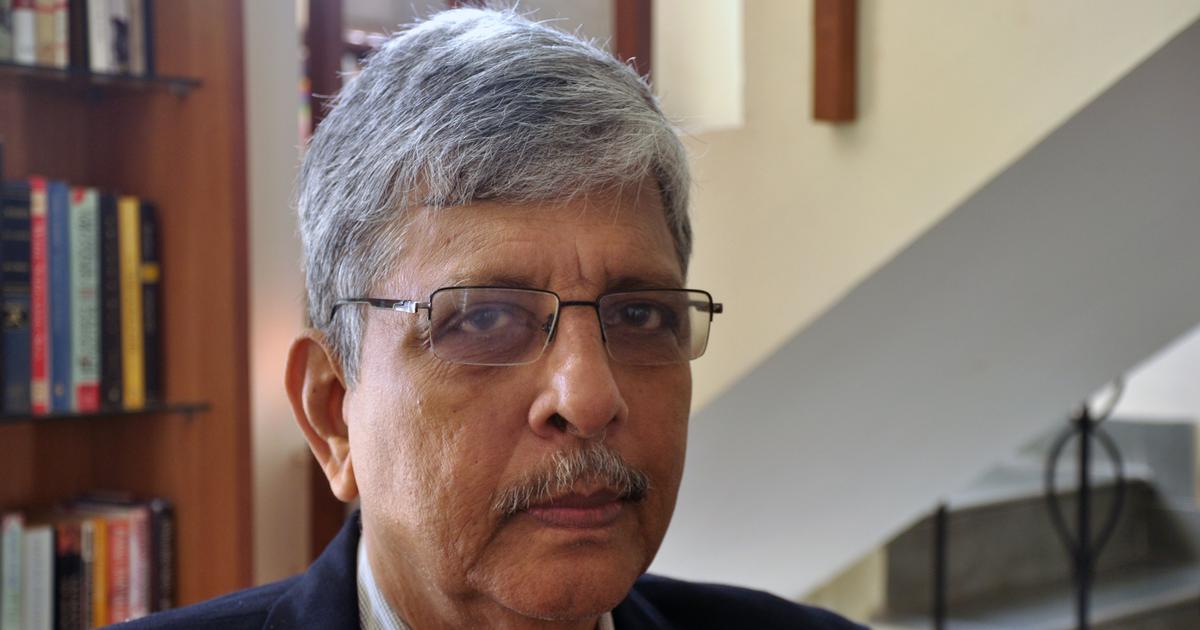
Of the five novels shortlisted for the inaugural JCB Prize for Literature, two were translations, and one, Benyamin’s Jasmine Days, was the winner. The other was Perumal Murugan’s Poonachi: Or The Story Of A Black Goat, which has been translated from Tamil into English by N Kalyan Raman. Raman has been translating Tamil fiction and poetry into English for the last two decades, for which he received the Pudumaipithan Award in 2017.
Some of the fiction writers he’s made accessible to an Anglophone audience include the late Ashokamitran, Devibharathi, Vaasanthi, Perumal Murugan, and Poomani. He has translated numerous Tamil poets, including forty poems by forty Tamil women poets for an anthology curated by Kutti Revathi. Speaking to Scroll.in, Raman detailed the ways in which the discourse around translated literature in India can be strengthened, his reaction to Poonachi being shortlisted for the JCB Prize, the immersive research he puts into translating the voices of identities he doesn’t inhabit – such as Dalit or female experiences – the need for recognising and supporting younger and newer Tamil voices, and much else. Excerpts from the interview:
In a previous interview, you’ve spoken of a learning curve in the skill of a translator. When looking back at your body of work, is it obvious to you that there’s been a gradual accruement of skill over the years? Can you talk to us a little about some of the ways in which you’ve grown as a translator over the years?
My first book as a translator, a collection of short stories by Ashokamitran, was published twenty years ago. Ten more have followed since. I can say with certainty that I am no longer the timorous amateur who worked on that first book. As to how skilled I am today as a translator, it is not for me to say.
A basic skill that I’ve learnt is: how to write a literary text of narrative prose fiction in English, with all the nuances – of voice, intent and context – of the original work intact. It took me several years to be able to do this effectively and with a degree of confidence.
Beyond that, translating poetry, especially women’s poetry, was a huge challenge. On the dimensions of language and form, writing the translation as a poem in English stretched my abilities as a creative writer. To be able to read these feminist poems right, I had to acquire a serviceable understanding of the cultural, political and emotional contexts of feminist poetry and discourse. So, I read a lot of women’s poetry, and tapped into my own personal exposure to and understanding of such themes and concerns. A similar process of self-education became necessary when I started translating Dalit and subaltern literary texts, both fiction and poetry.
In terms of personal growth, I have been able to work with texts across a variety of genres and themes, but they are only a tiny fraction of what exists out there.
You’ve pointed out that there is an insufficient ecosystem around literature in translation in India. Could you tell us about some of the ways in which you believe coverage in the media and organisation of events can support and critically evaluate translated literature and translators?
Literary texts in any Indian language (other than English) emerge from the literary tradition of that language and from the life and history of that language community. We need a discourse in English on translated texts that is alive to these contexts and is also able to meaningfully map these works to a wider Anglophone milieu. So, what we need is a cadre of reviewers with the necessary background and experience, who can contribute to the development of such a discourse, even across languages. Obviously, we need to encourage and accommodate such people within existing structures for reviewing and critical assessment. I am not able to say how feasible this might be.
As for translators, I think more of them should get into reviewing translated texts, to improve the state of the art, as it were, so that others might learn from it.
Indie presses devoted to translations can promote translated texts with more vigour and conviction than most mainstream publishers with a range of obligations are able to do. Web magazines devoted to translations and dialogue with translators, something on the lines of the Asymptote Journal, can do a world of good.
As for events, I think more sessions and panel discussions featuring only practising translators to cover the art and craft of translation would be a good idea. Identification of the best translations published each year and publishing profiles of their translators would also help to promote translated literature and bring it some level of prestige.
If there is a pie-in-the-sky feel to what I’ve said here, I guess that’s wholly unavoidable, given where we are right now.
What does being shortlisted for the JCB Prize mean for you?
It means a certain degree of public recognition and I am happy for it. As a translator, I am even more pleased that it’s a context where people can talk about and evaluate literary texts without worrying about the language of origin. As a translator, I am happy to be in the land of what Walter Benjamin has called a language beyond languages.
How often do you choose the texts you end up translating, and how often do people approach you to translate a text? What are some of the considerations before you take on a translation project?
In a majority of cases, I choose the text in consultation with the author (or their representative, as the case may be) and make a proposal to the publisher. I have also done translations under my own steam and found a publisher later. It’s rare for a publisher to approach me with a project of their own. It happened, though, with the two Perumal Murugan books I did recently.
For me, the consideration is always the literary significance of the text and my own personal engagement with it as a reader and critic. It would be impossible to translate a text that one didn’t feel strongly about.
Arshia Sattar has said that the jury of a literary prize must “seek the outlier, and not the conventional, mainstream writer.” Do you see the role of the translator in a similar way?
Well, a jury’s job ends with the selection of a winner, whereas a translator’s job begins with a choice, and if I may so, the latter involves a lot more work! Seriously, the two contexts are not strictly comparable because translation involves choosing from works produced over a long period. In the case of modernist Tamil literature, it is 80 years and counting. Moreover, the choice of works for translation is a collective, social enterprise and not just an aggregation of choices made by individual translators. There are many institutions as well as special interests involved.
That said, the number of works in modern Tamil literature that can and should be translated is huge and only a small fraction of that number has been published in translation. So, any translator would be spoilt for choice.
Right now the selection of books for translation is guided by good intentions on the part of all concerned – publishers, editors and translators – but it is also haphazard to the extent that there is no invisible hand behind this process to ensure that the best works in a particular language are translated on priority. Even among contemporary writers, some are pushed forward through contacts with publishers and others, equally meritorious, are ignored. An attempt at a broad-based and consultative selection of works for translation and finding publishers for them is being attempted in Malayalam through the university system. We might need some variant of this model as the engine for choosing works for translation from literature in every major Indian language.
There is another flaw in the current process which needs conscious correction. Selection of texts for translation is highly skewed in favour of well-known books by famous authors, in other words, modern classics published at least a few decades earlier. In the Tamil literary milieu, new and experimental writing, especially by younger writers, hardly ever makes it to the ranks of the chosen. This needs to change.
What were some of the most rewarding aspects of translating Poonachi? What were some of the challenges?
Poonachi is a very special work, a superbly imagined tale for our times, which is also profound in its exploration of the human condition through the life-trajectory of a little black goat. It was fun to bring this dazzling story alive in English. It is also gratifying to see that it has caught the imagination of the reading public across the country. It may even endure as a classic representing this particular, and particularly unfortunate, period in the life of our country.
Murugan’s prose style is elegant and modern even when he is describing the life of a subaltern community. In most of his works, the lives of his characters are inextricably merged with the terrain and landscape, trees and plants, along with bird and animals. Poonachi is a differently imagined story composed using the same elements. Having read his novels and written about them, I did not find this part difficult.
Poonachi is also filled with grief, especially towards the end, and reproducing his humane but unsentimental tone was quite a challenge. But the biggest challenge was meeting the deadline for publication, barely four months from start to finish. I, along with Karthika, my editor at Westland, did this book virtually on the run, and this was certainly a novel experience for me.
In the coming years, whose work would you like to see readers pay greater attention to? Whose work would you like to see translated into other languages?
I would like to see readers pay more attention to Ashokamitran. A lot of his work is available in English translation and much of it is world-class, but his work hasn’t received the kind of critical attention it deserves outside Tamil Nadu. It would be a great loss and a pity if his work doesn’t reach succeeding generations of Indian readers.
As for authors whose work I would like to see translated into other languages, especially English, here is a very personal list:
Fiction by older writers: Pudumaipithan, more of Sundara Ramasamy and Ashokamitran, Thi Janakiraman, Na Muthuswamy and fresh translations of Jayakanthan.
Fiction by living writers: More of Imayam, Devibharathi, Poomani, Jeyamohan, Vaasanthi. Experimental fiction by Payon.
Poetry: Atmanaam, Perundevi and Payon.
Plays: Na Muthuswamy and Indira Parthasarathi.
source: http://www.scroll.in / Scroll.in / Home> Meet The Translator / by Urvashi Bahuguna / November 04th, 2018
Veteran villupaattu exponent dead
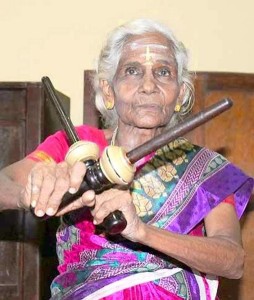
Poongani died in penury
Veteran villupaattu exponent, Poongani, 86, the country’s oldest ‘villupaattu’ performer, died at Kottaaram near here on Friday night.
Poongani, a recipient of the Om Muthumari Award, instituted by the Department of Journalism, University of Madras, was said to have performed at over a thousand events. She started practising at the age of 10 after getting inspired by ‘villupaattu twin sisters’ Lakshmi and Dhanalakshmi.
Besides taking stories from Ramayana and Mahabharata, Poongani spread the devotion of Amman through her performances.
The style of swinging the veesukol around her head and striking the bow with bells to the rhythm of the song gave her a unique identity. However, she never got an award from the State government.
Though she received 100% more than the male artistes in her troupe as salary, Poongani lived in a shack in abject poverty, subsisting on the government’s monthly old age pension of ₹1,000.
source: http://www.thehindu.com / The Hindu> Home> News> States> Tamil Nadu / by Special Correspondent / Nagercoil – November 03rd, 2018
U.K Parliament award for Palanivelu
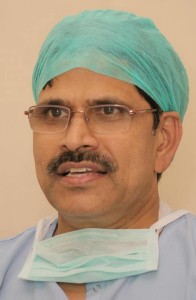
C. Palanivelu, Chairman of GEM Hospital in Coimbatore, was honoured with the award for “Original Contribution to the Development of Laparoscopic Surgery” at the House of Commons of the Parliament of the United Kingdom recently.
Baroness Lidia Antunes – Frederico, Chairman of Health Committee of Parliament of U.K., presented the award with medals and certificates. This makes Dr. Palanivelu the first Indian to be recognised in the Parliament of United Kingdom, among the 32 eminent medical professionals from various countries.
In his acceptance speech, Dr. Palanivelu observed that artificial intelligence and augmented reality would become part of robotic surgery soon. Navigational surgery was likely to emerge in clinical practice by incorporating information technology.
Dr. Palanivelu was also given special privilege to operate and teach in many countries including the U.K. without a formal post-graduate training, a press release said.
source: http://www.thehindu.com / The Hindu / Home> News> Cities> Coimbatore / by Special Correspondent / Coimbatore – November 03rd, 2018
A Tamil-language podcast that weaves through India’s past
The sailor arrives on Indian shores with his fleet of four ships. His fellow travellers have never seen anything like this before. The locals of the village are curious, some of them running to inform the king of this mysterious arrival.
The ‘hero’ of this tale, as recounted in Naveen Haldorai’s Tamil language podcast, Varalaru, is Portuguese explorer Vasco da Gama. And the year is 1498.
The four-episode-old podcast, which traces da Gama’s journey, is unabashedly historical. “History is not boring,” emphasises 28-year-old Haldorai. It lends itself to fast-paced narration. “It is loaded with stories, myths, facts and shocking truths that are relevant to what’s happening today. But the way it was introduced to us in school was boring.”
The podcast is not just for children, or even history buffs. It is for anyone who is up for a good story.
Varalaru starts with the host explaining why India was such a hot commodity for foreign conquistadors of the 15th century, before going on, in subsequent episodes, to explain the legacy of da Gama, one of the most well-known foreigners to embark on Indian soil.
With each episode running for less than 12 minutes, Haldorai’s crisp voice booms, supported by audio effects. Thunderous rainstorms? Waves lapping up on the shore? Check. And all this was launched with just one microphone and two volumes of history books, in a small room in his home in Vadavalli, Coimbatore. The result sounds like it was recorded in a studio.
Radio revolution
The 28-year-old is not new to the world of voice-based technology. He has worked as an RJ and a voice-over artiste for TV shows (Bigg Boss 2, notably), dabbling in freelance assignments as well. “I’ve always been interested in the audio medium,” he says.
He was in college when the radio boom happened in India, with several stations launching. Suddenly, everyone was tuning into a radio channel and he wanted to see what it was all about. With his deep voice and well-rounded Tamil, he got an offer to work as an RJ, which he did for 18 months. “The stint taught me how powerful the medium was,” says Haldorai, who also runs his mother’s company that produces millet-based noodles.
Just a few months old, the podcast only has around 550 listeners per episode, but the format is refreshingly unusual, the quality reflecting his extensive research and storytelling skills. “I plan to do a podcast on the Jallianwala Bagh massacre next,” he says. This week, his channel, Curry Podcasts, also released the first episode of a series of spooky stories for children. “All of us like a good ghost story, don’t we?”
Podcast mania
“There are so many budding podcasters in our country who are doing a good job,” he says, about the advent of the medium in India. “With media companies entering the fray, it will develop in the future.” He mentions Dan Carlin, the iconic former radio personality whose podcast, Hardcore History, has at least a million downloads per episode, ranking highly on any history loving audiophile’s list. “He releases just one podcast on American history every three or four months but they are really good. He captures the essence of a good story through his narration, so much so that he’s called America’s best history teacher,” says Haldorai.
According to him, a good podcast — as opposed to the video content that our timelines are flooded with — is like listening to an intimate conversation. “Right now, most of us are glued to our mobile phones, with our heads bent,” he says. “There will soon come a time when we hold our heads high, earphones plugged, listening to a podcast.”
Curry Podcasts is available on iTunes and Google Podcasts, among others.
source: http://www.thehindu.com / The Hindu / Home> Society / by Akila Kannadasan / November 02nd, 2018
It’s destination Europe for T.N. bananas
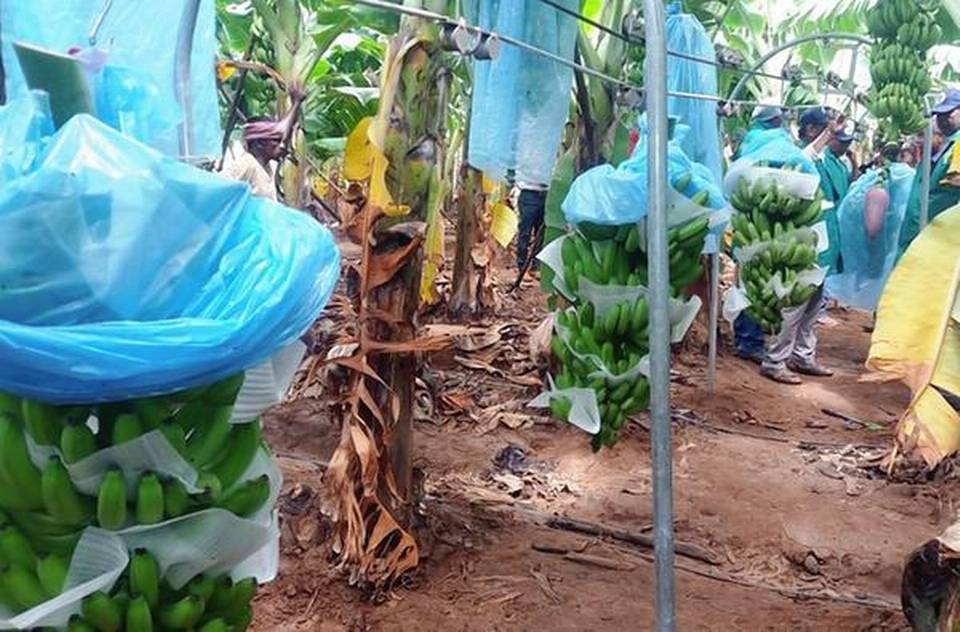
Thanks to a unique post-harvest handling system, a consignment will soon reach Italy
Despite India’s standing as one of the major banana-producing countries in the world, Tamil Nadu couldn’t export its produce by air given the fruit’s weight (making it uneconomical), its short shelf life and the European standards that lay emphasis on minimum human handling.
To counter this challenge, the Tamil Nadu Agricultural University in Coimbatore, in collaboration with the Tamil Nadu Banana Growers Federation, has developed a unique post-harvest handling system — the cable way conveyor. The Port of Trieste, Italy, offered financial support for developing the system.
Thanks to the initiative, the first consignment of bananas grown in the State was flagged off for export to Italy on Wednesday.
“The new system reduced the post-harvest loss. From the farm to packing-house, we managed with conveyors. The 24-day journey to Europe was the next step in the sequence,” explained Agriculture Secretary Gagandeep Singh Bedi.
The ‘cable way conveyor’ could be used in large farms for transporting both farm inputs and produce. It will help in exporting India-grown varieties like grand naine, red banana, ney poovan and nendran.
During the pioneering attempt, banana bunches with a sample size of about 400 kg were harvested at a farm in Kudalore in Theni district. They were then transported to the University of Udine, Italy, on an experimental basis. “After the positive results that we met with, we went ahead with the idea,” Mr. Bedi added.
As part of efforts to send the consignment to Europe, a ‘static inland simulation trial’ was conducted in Chennai by keeping a container fully stuffed with banana-packed pallets under climate-controlled atmosphere for three weeks. The National Research Centre for Banana, Maersk and the Tamil Nadu Banana Growers Federation too were part of the initiative.
The first consignment of grand naine variety from Theni district, produced and packed using the ‘post harvest protocol’, is to start its sea leg of the journey from Kochi in Kerala on November 1, according to an official release.
source: http://www.thehindu.com / The Hindu / Home> News> States> Tamil Nadu / by Special Correspondent / Chennai – November 01st, 2018
